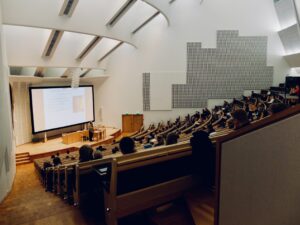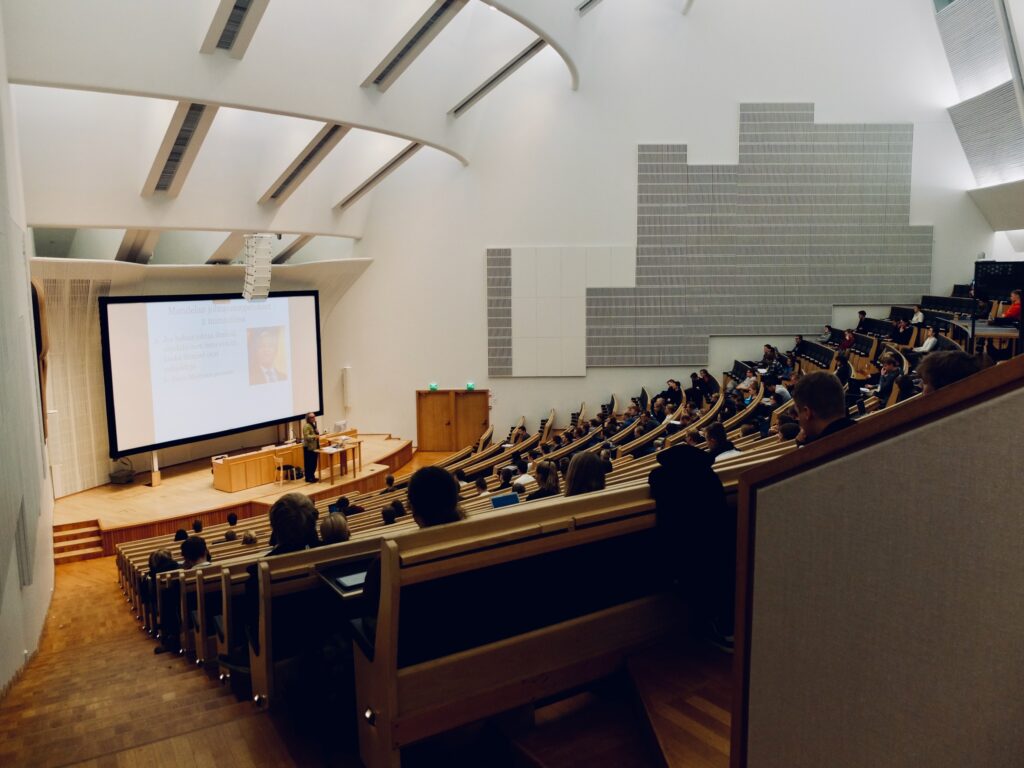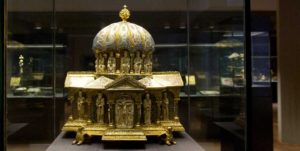
By Sarah E. Page
Pop culture is filled with references to hidden Nazi treasure. Monuments Men tells the story of the real hunt for stolen Nazi art[1] Television channels are rife with shows focusing on the search for hidden Nazi gold around the world.[2] However, one hoard is hidden in plain sight, and is now the subject of a dispute that made it all the way to the Supreme Court of the United States, which, in a decision released Feb. 3, sided with the treasure’s current owners regarding whether the dispute should be decided by U.S. courts.[3]
The collection, currently housed in Berlin’s Kunstgewerbemuseum,[4] is filled with artifacts of immense cultural and monetary value, and includes beautiful, gilded ecclesiastical artifacts such as the Cupola Reliquary, the Guelph Cross, and the Portable Altar of Eilbertus.[5] The beauty of the artifacts hides a long and rich history. Although that history originates in the beginnings of the German church, the conflict that brought the treasure before the Supreme Court is rooted in the beginnings of the Nazi Party’s control over Europe. In 1929, a consortium of Jewish art dealers based in Germany purchased the Guelph Treasure and displayed it around the world.[6] After their rise to power in 1933, the Nazi government began pressuring the group to sell their collection to Prussia, which promptly gifted the treasure to Hitler.[7] However, this transaction was for only a third of the collection’s appraised market value.[8]
The unjustly low price paid over 80 years ago is the cause of the current legal battle. A group of the original Jewish art dealers’ descendants composed of Alan Philipp, a resident of the United Kingdom, and United States residents Gerald Stiebel and Jed Leiber, [9] seek legal recourse for what they allege was an unjust transaction. Before availing themselves of the United States court system, the group first tried to use the Limbach Commission in Germany, which was established in 2003 to consider the fate of Nazi-acquired artifacts with questionable provenance that are currently in government possession.[10]
In that commission hearing, the museum foundation currently holding the collection argued that because the collection was in Amsterdam, and not under German control at the time of the sale, it cannot automatically be presumed that the Jewish art dealers faced pressure and threats from the Nazi Party to sell.[11] Arguably, this assertion failed to consider that one member of the group lived in Germany at the time of the deal, and while the treasure might not have been subject to Nazi control, the man may have felt that his life was in danger.[12] Furthermore, the museum claimed that because the market declined due to the Great Depression, the collection was worth much less at the time it was sold, and therefore the sale price was fair,[13] despite evidence of a letter from a Nazi official to Hitler outlining his intent to purchase the collection for a mere third of its value.[14]
The commission agreed with the museum, and determined that the Guelph Treasure was sold for a reasonable price that was not a result of duress.[15] Thus, the museum, whose deputy director has described the Guelph Treasure as “the highlight, the center, the heart of [their] medieval collection,” was not required to return the artifacts to the descendants of the original dealers.[16]
Understandably displeased, the heirs decided to bring their fight to the United States.[17] Most of their causes of action are straightforward, like replevin, conversion, and unjust enrichment;[18] but the question of whether an American court could actually decide these issues is a jurisdictional quagmire that halted the case’s progress in the U.S.
Both the district court[19] and the D.C. Circuit Court of Appeals[20] determined that the claims surrounding the sale of the Guelph Treasure were connected to the genocide of German Jews during the Holocaust, and therefore the Foreign Sovereign Immunities Act (“FSIA”) would not prevent the United States courts from gaining jurisdiction. But the museum appealed this decision to the Supreme Court, arguing that the FSIA’s expropriation exception should not apply, both because the claims are of a domestic taking, from a German citizen to the German government, and because the principle of international comity would require that American courts refrain from making a decision on a matter with only a tenuous connection to the United States.
Normally, foreign governments are granted sovereign immunity from suits in the United States under the FSIA, but there are a few exceptions.[21] Under the FSIA’s expropriation exception, when a foreign state takes property “in violation of international law,” and “that property or any property exchanged for such property is owned or operated by an agency or instrumentality of the foreign state and that agency or instrumentality is engaged in a commercial activity in the United States,” then the foreign government is susceptible to suits in the United States regarding the taken property.[22] The museum, of course, does not believe this exception applies.
The museum’s first contention seems to rest on the fact that the actual transaction only involved German parties, that the sale itself did not violate international law, and that the transaction’s connection with the horrors of the Holocaust cannot bring claims surrounding the transaction under the purview of the expropriation exception.[23] The taking itself must violate international law, and historically, that can only happen when the government takes from a foreign national.[24] The heirs of the art dealers argue that the court should consider only the plain text of the law, and as “taken in violation of international law” is not defined within the FSIA statute and not an obvious term of art, it should be interpreted according to its plain meaning.[25] Because genocide is an obvious violation of international law, and the potentially unjust sale of the Guelph Treasure was directly related to the Holocaust genocide, then the sale should render the treasure “taken in violation of international law.”[26]
Although the museum is correct and the sale of the Guelph collection was not genocide, Justice Thomas suggested in oral argument that it is impossible to separate actions taken by the Nazi party against the German Jewish population from the Holocaust.[27] However, despite this incisive comment during argument, Justice Thomas joined in a unanimous decision to vacate the lower courts’ interpretation of the expropriation exception.[28] Writing for the court, Chief Justice Roberts adopted the German museum’s perspective on the FSIA.[29]
Because the rest of the FSIA mentions only property related offenses, the Supreme Court stated that the expropriation exception should not be extrapolated to apply to events surrounding human rights violations.[30] This is because international law governing property tends to abide by the “domestic takings rule,” which holds that a government’s seizure of the property of its own citizen is not a matter governed by international law.[31] The Court articulated that Congress’s intention to allow American courts to intervene only when there is state action against property held by a citizen of another state is obvious because the verbiage used in the FSIA expropriation exception is identical to that of the Second Hickenlooper Amendment to the Foreign Assistance Act of 1964.[32] This amendment dictated that federal courts could intervene in situations in which foreign nations had taken adverse action against the property of a non-citizen, and was passed as a reaction to the former Supreme Court’s reluctance to exercise jurisdiction over the actions of a foreign nation on foreign soil involving an American company’s property.[33] However, Congress did not alter the traditional “domestic takings rule” when it passed the Second Hickenlooper Amendment, and instead left state actions against the property of their own citizens out of the purview of international law.[34] Because the sale of the Guelph Treasure was a transaction between German citizens, there is no invocation of international law, and therefore, there is no possibility that the transactions could have violated international law for the purposes of jurisdiction under the FSIA exception.[35]
However, the Supreme Court did leave one small door open to allow the dealers’ descendants another chance at U.S. jurisdiction. If the dealers were no longer considered German citizens at the time of the transaction due to Germany stripping Jewish Germans of citizenship status, the “domestic takings rule” may not apply.[36] However, the Court declined to address this important factor and sent the issue back to the district court to ascertain whether that issue was properly preserved for appeal.[37]
The museum’s next argument is that the principle of comity should prevent American courts from presiding over these claims because Germany has a system that would adjudicate the claims and because the claims hold significant historical and political implications for Germany.[38] At a basic level, comity is the principle that governments should respect the governmental decisions of foreign states.[39] After asserting comity, the nation of Germany was dismissed as a party to the case, but the museum foundation asserts that this principle should cover them as well.[40] The descendants contend that not only is the museum’s comity argument just a restatement of the forum non conveniens argument that was dismissed earlier and not appealed,[41] but also that discretionary comity would be inappropriate here because the descendants would not be able to recover for their claims in Germany.[42] The Supreme Court artfully avoided stepping on international toes by declining to address this issue and basing the outcome of the case solely on the dispute under the FSIA.[43] Therefore, the issue of comity in similar cases is left for another day.
On one hand, the Supreme Court had a sympathetic set of plaintiffs and extreme, visceral disgust for the atrocities committed by the Nazis during the Holocaust. On the other hand, the Court faced the possibility of overly encroaching on international affairs.[44] Although faced with two very compelling arguments and the competing goals of both preserving international relations and recognizing the injustices inflicted on the German Jews by the Nazis, the Court effectively struck a balance between preserving traditional tenants of international law and recognizing the injustices that faced the art dealers at the time of the sale.[45]
[1] See Monuments Men Found., https://www.monumentsmenfoundation.org (last visited Feb. 4, 2021).
[2] See Hunting Nazi Treasure, Nat’l Geographic Channel, https://www.natgeotv.com/ca/hunting-nazi-treasure/about (last visited Feb. 4, 2021); Lost Gold of World War II, History, https://www.history.com/shows/lost-gold-of-world-war-ii (last visited Feb. 4, 2021); Nazi Gold Train, Travel Channel, https://www.travelchannel.com/shows/expedition-unknown/episodes/nazi-gold-part-1 (last visited Feb. 4, 2021).
[3] Federal Republic of Germany v. Philipp, No. 19-351, slip op. at 1, 16 (U.S. Feb. 3, 2021), https://www.supremecourt.gov/opinions/20pdf/19-351_o7jp.pdf.
[4] Hilary McDonnell, An Uncertain Fate for the Guelph Treasure, Hughes Hubbard & Reed (Nov. 11, 2020), https://www.hhrartlaw.com/2020/11/an-uncertain-fate-for-the-guelph-treasure/.
[5] What is the Guelph Treasure?, Stiftung Preußischer Kulturbesitz,
http://www.preussischer-kulturbesitz.de/newsroom/dossiers-and-news/all-dossiers/dossier-the-guelph-treasure/what-is-the-guelph-treasure.html?no_cache=1&L=1 (last visited Feb. 4, 2021).
[6] McDonnell, supra note 4.
[7] Id.
[8] Brief for Respondents at 5, Federal Republic of Germany v. Philipp, No. 19-351 (U.S. Oct. 22, 2020), https://www.supremecourt.gov/DocketPDF/19/19-351/158522/20201022151404770_Respondents%20Brief.pdf.
[9] Brief for Petitioners at ii, Federal Republic of Germany v. Philipp, No. 19-351 (U.S. Sept. 4, 2020), https://www.supremecourt.gov/DocketPDF/19/19-351/153210/20200904172357322_2020-09-04%20Brief%20of%20Petitioners.pdf.
[10] Nicholas O’Donnell, Limbach Advisory Commission Recommends Against German Restitution of “Guelph Treasure,” Focuses on Terms of 1929 Agreement for Intended Sale, Sullivan &Worcester: Art L. Rep. (Mar. 26, 2014, 11:54 AM), https://blog.sullivanlaw.com/artlawreport/2014/03/26/limbach-advisory-commission-recommends-against-german-restitution-of-guelph-treasure-focuses-on-terms-of-1929-agreement-for-intended-sale/.
[11] Christopher F. Schuetze, U.S. Supreme Court to Rule on Medieval Treasure Bought by Nazis, N.Y. Times (July 10, 2020), https://www.nytimes.com/2020/07/10/world/europe/guelph-treasure-germany-us.html.
[12] Schuetze, supra note 11.
[13] O’Donnell, supra note 10.
[14] Brief for Respondents, supra note 8, at 4.
[15] Brief for Petitioners, supra note 9, at 6.
[16] Schuetze, supra note 11 (quoting Lothar Lambacher).
[17] Nicholas O’Donnell, Civil Action Filed Against Germany for Restitution of Guelph Treasure, Sullivan &Worcester: Art L. Rep. (Feb. 24, 2015, 12:27 AM), https://blog.sullivanlaw.com/artlawreport/topic/philipp-v-federal-republic-of-germany-et-al-15-cv-.
[18] Joint Appendix at 125–26, Federal Republic of Germany v. Philipp, No. 19-351 (U.S. Sept. 4, 2020), https://www.supremecourt.gov/DocketPDF/19/19-351/153235/20200904173042682_2020-09-04%20Joint%20Appendix.pdf.
[19] Philipp v. Federal Republic of Germany, 248 F. Supp. 3d 59, 70–72 (D.D.C. 2017), aff’d, 894 F.3d 406 (D.C. Cir. 2018), vacated, No. 19-35,1 slip op. (U.S. Feb. 3, 2021), https://casetext.com/case/philipp-v-fed-republic-of-ger.
[20] Philipp v. Federal Republic of Germany, 894 F.3d 406, 410–413 (D.C. Cir. 2018), vacated, No. 19-35,1 slip op. (U.S. Feb. 3, 2021), https://casetext.com/case/philipp-v-fed-republic-of-germany-2.
[21] Amy Howe, Argument Preview: Pleading Standards and the “Expropriation” Exception to the FSIA, SCOTUSblog (Oct. 27, 2016, 2:10 PM), https://www.scotusblog.com/2016/10/argument-preview-pleading-standards-and-the-expropriation-exception-to-the-fsia/.
[22] 28 U.S.C. §1605(a)(3), https://www.govinfo.gov/content/pkg/USCODE-2011-title28/html/USCODE-2011-title28-partIV-chap97.htm.
[23] Brief for Petitioners, supra note 9, at 16–18.
[24] Id. at 22–26.
[25] Brief for Respondents, supra note 8, at 11–12.
[26] Id. at 12–13.
[27] Coleman Sanders, Summary: Supreme Court Oral Argument in Federal Republic of Germany v. Philipp, Lawfare (Jan. 12, 2021, 1:19 PM), https://www.lawfareblog.com/summary-supreme-court-oral-argument-federal-republic-germany-v-philipp.
[28] Philipp, slip op. at 15–16.
[29] Id. at 1, 7.
[30] Id. at 4–5.
[31] Id. at 4–6.
[32] Id. at 7–8; see also 22 U.S.C. § 2370(e)(2).
[33] Philipp, slip op. at 7–8; § 2370(e)(2).
[34] Philipp, slip op. at 7.
[35] Id. at 8.
[36] Brief for Respondents, supra note 8, at 27.
[37] Philipp, slip op. at 16.
[38] McDonnell, supra note 4.
[39] Brief for Respondents, supra note 8, at 9–10.
[40] Id. at 10.
[41] Id. at 43.
[42] Id. at 54–55.
[43] Philipp, slip op. at 15–16.
[44] Brief for Petitioners, supra note 9, at 49–50.
[45] Philipp, slip op. at 13 (hinting at potential retaliation if an American court claimed jurisdiction over these claims).
Post image of the Cupola Reliquary, courtesy Kunstgewerbemuseum. Photo by Fabian Frohlich.








